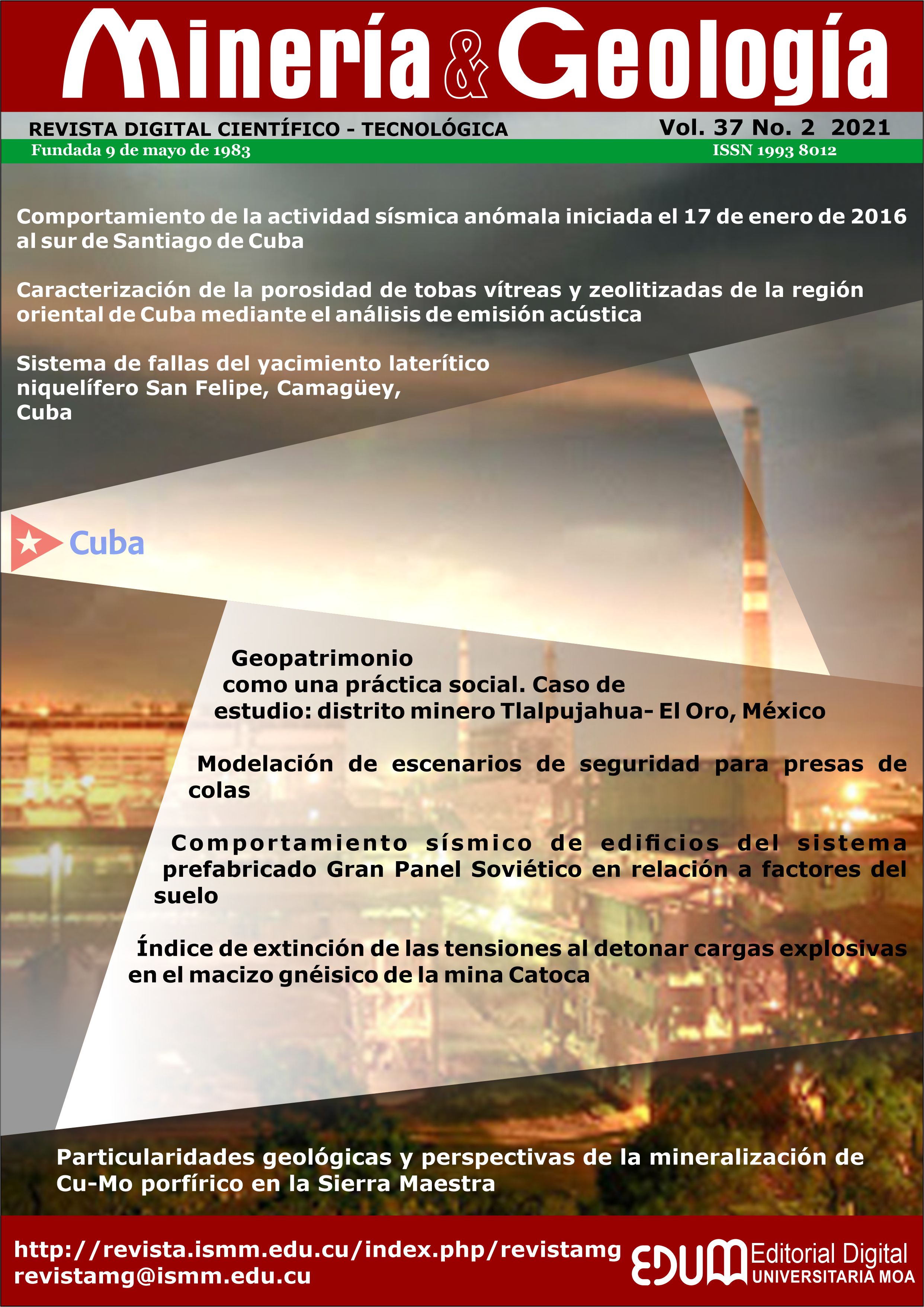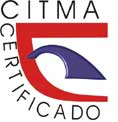Anomalous seismic activity performance in January 17, 2016 in southern part of Santiago de Cuba
Keywords:
seismic activity, aftershocks, Santiago de Cuba, seismic moment tensor, Kagan angle.Abstract
Performance and possible causes of seismic activity in the southern of Santiago de Cuba province were evaluated, based on the geological and tectonic information available and records of the earthquakes occurred in this region in January 17, 2016 at 08:17 UTC. The analysis of the space-time-energy parameters of the earthquakes showed the coherence between the results of three of the networks monitoring the region, namely, the Cuban National Seismological Service (SSNC), the United States Geological Service (USGS) and the German Center for Geo-scientific Research (GEOFON)). For three of the earthquakes, the seismic moment tensors were calculated by reversing the corresponding waveforms. Comparing the results of two of them with those obtained by other agencies that monitor the area was totally consistent with fault planes oriented N-S with compressive focal mechanisms. The third earthquake, which occurred a week later in the east of the province, also had a compressive mechanism, although with a NW-SE orientation on the fault plane. The seismic activity that initially performed like a swarm of earthquakes, performed differently later; similar to aftershocks registered after a higher-energy earthquake, following Omori's Law, that is, the type of premonitory-main earthquake event –aftershocks.Downloads
References
Arango E. D. 2014: Análisis sismotectónico del territorio oriental de Cuba a partir de la integración del modelo de corteza 3D de datos gravimétricos con datos sismológicos y geodésicos. Tesis Doctoral. Centro de Investigación Científica y de Educación Superior de Ensenada, Baja California, México.
Arango, E., González, O., Palau, R. y Leyva, M. 2017: Evaluación del comportamiento de la actividad sísmica de Corralillo iniciada el 9 de enero de 2014. Revista Ciencias de la Tierra y el Espacio, 18(1): 71-85.
Brocher, T.M. 2008: Key elements of regional seismic velocity models for long period ground motion simulations. Journal of Seismology, 12(2): 217–221, doi: 10.1007/s10950-007-9061-3.
Calais, E. 1988: Aspect structural d une limite de plaques en coulissage: La froteniére Nord-Caraibe de Cuba á Hispaniola (Grandes Antilles). Diplome d´études approfondies a l´Universite de Bretagne Occidentale. Archivo CENAIS, 118p.
Calais, E. y Lepinay, B.M., 1991: From transtension to transpression along the northern Caribbean plate boundary off Cuba: implications for the Recent motion of the Caribbean plate. Tectonophysics, 186(3-4): 329-350.
Calais, E., Béthoux, N., y Lepinay, B.M., 1992: From transcurrent faulting to frontal subduction: A seismotectonic study of the Northern Caribbean plate boundary from Cuba to Puerto Rico. Tectonics, 11(1) : 114-123.
Chuy, T. 1999: Macrosísmica de Cuba y su aplicación en los estimados de peligrosidad y microzonación sísmica. Tesis en opción al Grado de Doctor en Ciencias Geofísicas. Fondos del MES y CENAIS. 150 p.
Dreger D. S. 2002: Time-DomainMoment Tensor INVerseCode (TDMT_INVC) Version 1.1, Berkeley Seismological Laboratory, pp. 18.
García, J.; Slejko, D.; Alvarez, L.; Peruzza, L.; Rebez, A. 2003: Seismic hazard maps for Cuba and sorrounding areas. Bull. Seism. Soc. Am., 93(6): 2563-2590.
Goldstein, P. 1999: SAC User’s Manual, Lawrence Livermore Laboratory, University of California.
González, O., Moreno, B., Romanelli, F. y Panza, G.F. 2012: Lithospheric structure below seismic stations in Cuba from the joint inversion of Rayleigh surface-waves dispersion and receiver functions. Geophys. J. Int., 189(2): 1047–1059. DOI: 10.1111/.j.1365-246X.2012.05410.x.
Graves, R. W., y Pitarka, A. 2004: Broadband time history simulation using a hybrid approach, Proc. En: 13th World Conf. Earthquake Eng., Vancouver, Canada, paper no. 1098.
Havskov, J. y L. Ottemøller. 2000: SEISAN earthquake analysis software. Seis. Res. Lett., 70(5): 532-534.
Havskov, J. y Ottemöller, L. 2010: Routine Data Processing in Earthquake Seismology. Springer Science+Business Media B.V. DOI 10.1007/978-90-481-8697-6_5.
Kagan, Y.Y. 1991: 3-D rotation of double-couple earthquakes sources. Geophys. J. Int., 106(3): 709-716. doi: 10.1111/j.1365-246X.1991.tb06343.x.
Krizova, D., Zahradnik, J., y Kiratzi, A. 2013: Resolvability of isotropic component in regional seismic moment tensor inversion. Bull. Seism. Soc. Am., 103(4): 2460–2473.
Mann P., Calais E., Ruegg J. C., DeMets Ch., Jansma P. E. y Mattioli G. S. 2002: Oblique collision in the northeastern Caribbean from GPS measurements and geological observations. Tectonics, 21(6): 1057.
Mogi, K. 1963: Some discussions on afterhsocks, foreshocks and earthquake swarms, the fracture of a medi-infinite body caused by inner stress origin and its relations to earthquake phenomena. Bull. Earthq. Res. Inst. Tokyo Univ., 41(3): 615-58.
Moreno, B., Grandison, M. y Atakan, K. 2002: Crustal velocity model along the southern Cuba margin: implications for the tectonic regime at an active plate boundary, Geophys. J. Int., 151(2): 632–645.
Nafe, J.E., yand Drake C.L. 1960: Physical properties of marine sediments, in The Sea, Vol.3, M.N.Hill (Editor), Wiley-Interscience, NewYork, 794–815.
Omori, F. 1894: On the aftershocks of earthquakes. Journal of the College of Science, Imperial University of Tokyo, 7: 111–200.
Sokos, E. N., y J. Zahradník. 2008: ISOLA a Fortran code and a Matlab GUI to perform multiple point source inversion of seismic data. Computers and Geosciences, 34(8): 967-977.
Sokos, E. N., y J. Zahradník. 2013: Evaluating centroid-moment-tensor uncertainty in the new version of ISOLA software. Seismol. Res. Lett., 84(4): 656-665.
Tsunami Laboratory. 2011: ICMMG SD RAS, Novosibirsk, Russia, Historical Tsunami Database for the World Ocean (HTDB/WLD), 1628 B.C to present, online http://tsun.sscc.ru/nh/tsunami.php.
Utsu, T. 1961: A statistical study of the occurrence of aftershocks. Geophysical Magazine, 30: 521–605.
Vackář J., J. Burjánek, y J. Zahradník. 2015: Automated detection of long-period disturbances in seismic records; MouseTrap code. Seism. Res. Letters, 86(2A): 442-450.
Wessel, P., W. H. F. Smith, R. Scharroo, J. Luis, y F. Wobbe, 2013: Generic Mapping Tools: Improved Version Released, EOS Trans. AGU, 94(45): 409-410. doi:10.1002/2013EO450001.
Zahradník, J., y A. Plešinger. 2005: Long-period pulses in broadband records of near earthquakes, Bull. Seismol. Soc. Am., 95(5): 1928–1939, doi10.1785/0120040210.
Zahradník, J., y A. Plešinger. 2010: Toward understanding subtle instrumentation effects associated with weak seismic events in the near field. Bull. Seismol. Soc. Am., 100(1): 59–73, doi 10.1785/0120090087.
Zahradnik, J., y Custodio, S. 2012: Moment Tensor Resolvability: Application to Southwest Iberia. Bull. Seismol. Soc. Am., 102(3): 1235–1254. doi:10.1785/0120110216.
Published
How to Cite
Issue
Section
- Authors retain copyright and guaranteeing the right magazine to be the first publication of the work as licensed under a Creative Commons Attribution-NonCommercial that allows others to share the work with an acknowledgment of the work's authorship and initial publication in this journal.
- Authors may establish separate supplemental agreements for the exclusive distribution version of the work published in the journal (eg, place it in an institutional repository or publish it in a book), with an acknowledgment of its initial publication in this journal.
- Authors are allowed and recommended to disseminate their work through the Internet (e.g., in institutional telematic archives or on their websites) before and during the submission process, which can produce interesting exchanges and increase citations of the published work. (See The effect of open access)










